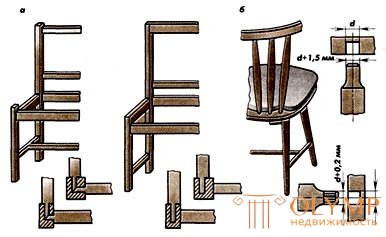
Typical joinery chairs are subdivided into two basic types: the bars of the rear legs turn into vertical bars of the backs, i.e., with one-piece back legs (Fig. 1 a), and whose back legs and vertical bars of the backs consist of different parts . The latter are called chairs with stool legs (Fig. 1 b).
 | 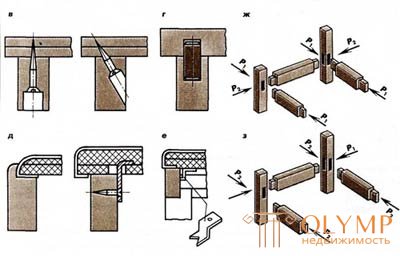 |
| Fig. 1. Structures and schemes for assembling carpentry chairs: a - with solid rear legs; b - with stooping legs; in - e - ways of fastening connections; W - C - Sequence diagrams for the assembly of a chair with solid rear legs; and - the angles of inclination of the legs and back in chairs with stool legs. | |
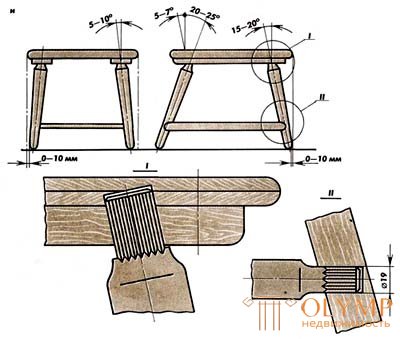 | 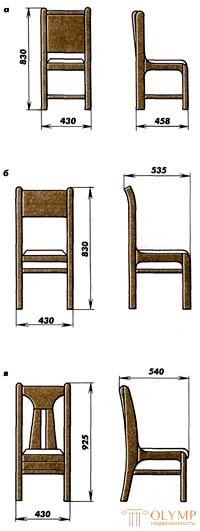 |
Joiner's chairs are mainly made with specks. The strength of chairs with specks is, on average, 50% higher than chairs, the tone of the same design, but with no leads. The presence of only the side arms significantly increases the strength of the chair and, consequently, its useful life.
The strength of carpentry chairs depends largely on the correct choice of the size of spiked joints and sections of parts of the chair. In all cases, to increase the bonding area, the length and width of the spikes should be as large as possible. The spike should fit snugly and be nest-shaped.
For chairs, the front side bar of which is flush with the side bar, the area of gluing spikes is less than that of chairs with the front bar side down. When connecting stool legs, a round one-piece spike is compressed in a special fixture.
For joiner's chairs made from hardwood, the minimum dimensions of square legs in cross section are 28x28 mm, rectangular legs are 22x40 mm, and tarsi are 22x50 mm. In the manufacture of carpentry chairs from coniferous wood, the minimum dimensions of square legs in cross section 40x40 mm, rectangular 30x45 mm, tsar 30x60 mm. Diameter of stool legs 35 mm.
The seats of the joinery chairs are made of panel and frame, each of which can be hard and soft.
Board seats are usually made of chipboard, plywood, solid wood. The thickness of the seats - 10-16 mm. The seat depth (distance from the front edge of the seat to the back leg of the chair) is 360 to 450 mm. Frame seats are used in cases where it is necessary to form a flexible or elastic base.
Depending on the method of installation, the seats are made superimposed, superimposed on the tsarg, or supplementary, installed between the tsarg or inserted into the quarter selected in the tsarg. In many cases, seat installation can be combined.
Overhead seats with a thickness of at least 10 mm are fixed with screws (Fig. 1c), which are screwed from the side or the inner side of the tsarg. Overhead seats, 5-6 mm thick, are fixed with screws with a half-head that are screwed from the outer surface of the seat. The connection on the dowels (Fig. 1 g) is used in cases where the base of the seat is a frame or plate. The glue connection (Fig. 1e) is recommended for seat-ins. The connection shown in Figure 1e is made with metal clips.
Joiner's chair and softwood with solid rear legs, shown in Figure 1a, consists of the rear and front legs, tsarg, side and middle projectiles, worsted and lower wall bars, backrest bars, and a soft seat. All parts of the chair, with the exception of the rear legs, are straight.
The rear legs of the chair are laid out on a pattern, cut out along the marking lines and cut with a planing tool. Then, according to the drawing, the parts are laid out, and after the formation of spines and nests, they proceed to the assembly of the frame of the chair “dry”.
The assembly of the frame of the chair is divided into the assembly of the front, rear and side blocks.
When assembling a chair, in which the anterior and lateral tsargos are located on the same level, first assemble the front and rear blocks (Fig. 1 g), compressing them in the zwinge in the direction of arrow P ,. Then the blocks are disassembled, cleaned and glued. After the glue dries, the chair frame is collected "dry", crimping it in zwings in the direction of arrow P2. Then the frame is disassembled, the upper block of the backrest is machined according to the template, they are stripped of all the details of the frame and glued. In chairs, in which the ends of the legs are at the level of the tsarg, the legs are sawed after gluing the frame. If the ends of the front legs are sawed in blocks, then when assembling the carcass of the chair in places where the spikes of the side pillars are mated with the nests of the front legs, the wood may split, resulting in a broken connection.
When assembling the chairs, in which the anterior side is located below the lateral ones (Fig. 1 h), it is necessary to assemble the side blocks first, compressing them in the direction of the arrow P ,. In this case, it is possible to process the block, including filing the butt of the front legs, before assembling the frame. After processing the blocks, the frame of the chair is assembled, compressing it in zwing in the direction of the arrow P2.
Trim chairs after final assembly and stripping. Softwood chairs should be free of resin.
Making a carpentry stool with stooping legs is somewhat more complicated than a chair with solid back legs. This is due to the fact that the details of the stool with stool legs are at different angles to each other, which makes it difficult to form spike joints with hand tools and assemble the chairs. Therefore, before proceeding to the manufacture of a chair, it is advisable to develop its drawing on a scale of 1: 1.
The basic detail when designing a chair drawing is the seat. The shape of the seat of the chair in the plan can be rectangular or square, with rounded corners and edges, round, oval. When designing the seat shape, it is necessary to take into account that the depth of the seat in the center (the distance from the front edge of the seat to the backrest parts) must be at least 360 mm. The angles of inclination of the legs and back are shown in Figure 1 and.
The seat is made of plywood with a thickness of 15 mm or solid wood with a thickness of 25-30 mm. On the underside of the seat, in the places where the legs are installed, fix solid wood of hardwood to the glue and screws. The total thickness of the bar and the seat should ensure the drilling of the socket for a round spike 30-35 mm long.
The seats are hard and soft. In the upholstered seat, a soft, soft, two-sided element is fixed with a fabric tape with a fastener under the seat.
The legs and proocks of the chair are round and hexagonal in cross-section, and they are connected to a round one-piece thorn with a compression of the thorn in the fixture. Thorn diameter for hardwood legs is at least 25 mm, for softwood legs is at least 30 mm. The diameter of the thorn of the lateral prozhek 19 mm, average prozhok 14-16 mm
The back of the chairs with stooping legs can be shield solid wood or trellised.
The shield back is 25 mm thick attached to the seat on four dowels with a diameter of at least 14 mm. To increase the strength it is advisable to provide an additional two screw or screw ties, installed at the bottom of the seat.
The lattice back consists of vertical round or hexagonal parts in cross section and the upper lumbar bar. The extreme vertical details of the lattice back are carrying, the middle ones play a mostly decorative role.
With the seat and the lumbar backrest bar, the extreme vertical parts are connected to a single round spike with a diameter of 20 mm with the spike being compressed in the device. The middle vertical details of the back are connected to a round one-piece spike with a diameter of 14-16 mm. The upper lumbar block of the back is drunk from solid wood or bentle glued from 10 mm thick planks, the radius of curvature of the bar is 220 mm. Section of bar 50x30 mm.
The sequence of manufacturing a chair with stool legs:
Make the seat of the chair and fasten from the underside of the seat bars for mounting legs and extreme vertical bars of the backrest.
Harvest legs and lateral proocks of the chair. In the manufacture of chairs with stooped legs with a hand tool, all the round, hexagonal or other figure-shaped parts, in which the studs for the spikes are formed, are previously performed rectangular. Drilling the sockets with the hand tool in the details of the figured form does not provide the required accuracy and quality.
Mark up and drill nests. Drill nests in the details at an angle greater or less than 90 ° should be using a template (bar) of hardwood 40 mm thick. In the bar, pre-drill holes at the desired angle for the direction of the drill. When drilling nests, the bar is attached to the workpiece with a clamp.
Handle the details to give them the desired shape (circle, hexagon) and form spikes.
Gather the bottom block of the chair. Install the legs and prokhozhki "dry", cleaned parts, assemble the lower unit on the glue.
Level the legs. Install the lower unit on a flat plane, align the legs with a saw or chisel. Round and trim the ends of the legs.
After leveling the legs of the chair should rest on the plane of the four legs.
Assembling the chair: Install the backrest parts "dry", clean the parts, assemble the chair with glue. Check the assembly of the chair with a ruler.
The angle of the backrest parts to the seat is checked with a template.
Finally cleaned and trim the chair. Install and fix the soft element.
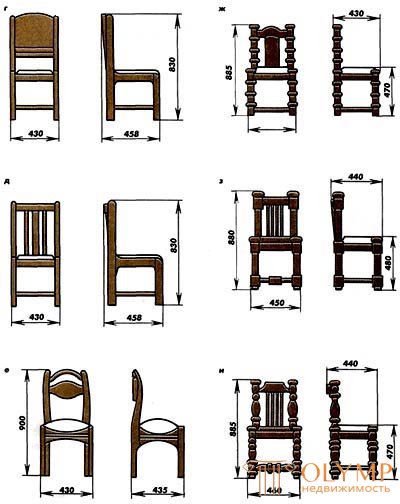 | 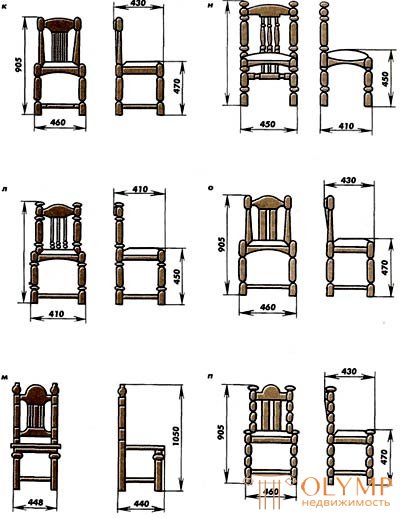 |
Chairs are the most popular furniture products. Figure 2 shows the chairs recommended for manufacturing in home workshops. All the above models of chairs can be made of solid wood conifer prod.
Chairs from flat parts (Fig. 2 a – e) are the most economical and less labor-intensive. For the manufacture of a chair with curvilinear details (Fig. 2e), approximately 10–1 2% more materials are required than for a chair with flat parts. In addition, the complexity of manufacturing such chairs increases. The chair has double anterior and lateral tsargs, therefore, in the chairs of this design, the projectile can not be used.
Chairs from figured details can have round turned and square legs and progresses.
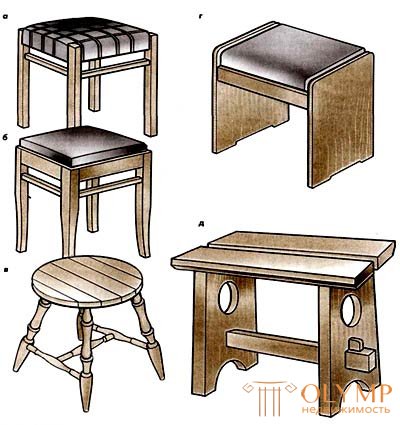
Stools. Joiner's stools can be squared (Fig. 3a — c) and shield stools (Fig. 3 d, e), with a hard, flexible and soft seat. A stool with a soft seat is called a stool. The seat of the stool is a soft element of one- or two-sided softness using a springless unit.
The minimum dimensions in cross-section of square legs of solid hardwood stools are 28x28 mm, 22x50 mm tsars, softwood stools, respectively, 40x40 mm, 22x60 mm tars. The legs are connected to the tsarg and prokhozhk on the thorn single single, not through. Connections in stool with stool legs are the same as in chairs.
Board stools are made of chipboard and solid wood. Chipboard stools (see Fig. 3 d) consist of two vertical walls, a seat and two tsargs. Details connect on shkanta with glue and couplers. The edges of chipboard should be lined with veneer or plastic. On the lower edges of the vertical walls set the claws.
A stool made of solid wood is shown in Figure 3 d. The stool consists of vertical walls, pro-planes and a seat. All details of the stool are made from softwood lumber 25 mm thick.
The stool arm is connected to the vertical walls with a wedge. Since the wedge joint and the width of the prostate mainly provide rigidity of the stool, the width of the protage must be at least 60 mm. The seat of the stool consists of two parts. They are connected with vertical walls on the dowels with glue and additionally fasten with squares. To increase the rigidity of the stool, you can provide two tsargami width of 40 mm. Tsargs with vertical walls are joined to the dovetail thorn. In this case, the seat is attached to the tsargs with screws.
The dimensions of the seats of the stools in terms of (not less): square 320x320 mm, rectangular 320x400 mm. The diameter of the round seats is not less than 320 mm. In high stools (650 mm and more) it is necessary to provide a support (propozh) for legs.
The stools are trimmed with nitrolacks and enamels. The seats can be lined with plastic, film materials, upholstered with fabrics. Seats from solid wood of softwood do not grind.
Что бы оставить комментарий войдите
Комментарии (0)